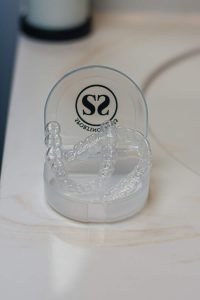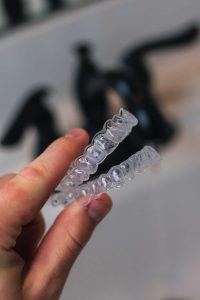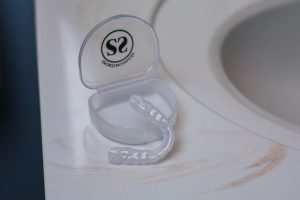Your orthodontic journey doesn’t stop when your braces are taken off. It’s important to wear your retainer as directed by your orthodontist. Your teeth may shift back to their original position if you don’t wear a retainer for a month or even a week, undoing the progress you made throughout your orthodontics treatment.
But, what happens if, after braces, you do not wear a retainer for a month?
We’ll talk about this plus the following in this article:
- What are the results of not wearing a retainer for a month?
- Can you wear a retainer after a month of not wearing it?
- How long can you go without wearing a retainer?
- What do you do if you haven’t worn your retainer for a month?
We hope this article will answer all the questions you may have about not wearing a retainer for a month and will help you in completing your orthodontic treatment.
Read more information about teeth retainers here.
Not wearing a retainer for a month, can cause your teeth to shift back and you may risk having to start all over again with braces.


Sporting Smiles makes it easy to order customized retainers online, without visiting the dentist. You can choose from various packages and prices, and they keep your teeth impressions on file so it’s easy to reorder in the future.
Plus, they’re only half the cost of what you would pay at your dentist. Get yours now! And find out more in our Sporting Smiles review.
[/featured_box]
What happens when, after braces, you don’t wear your retainer for a month?
Your teeth move back to their original positions after a month of not using a retainer. Your teeth may begin to move in as little as a week, depending on how recently you had orthodontic treatment. It may not be much, but with time, all the effort you put into perfecting your smile will be undone.
According to the American Dental Association, even if you wear your retainer for the first few years after braces, it’s not enough to keep your teeth in line after – lifetime retention is necessary.
The first thing you should do if you lose your retainer is start looking for it right away. The likelihood that your teeth may start to move increases as time goes on. Thankfully, you have a few choices, like emergency retainers, if your retainer has been misplaced, damaged, or is just too nasty to use.
What do you do if you haven’t worn your retainer for a month?
You shouldn’t start wearing your retainer right away if you haven’t worn it for a month or longer. You run the risk of hurting yourself if you try to push your retainer in forcefully. Your teeth could have already started to move back to their natural positions.


If you have to press your retainer back onto your teeth, it no longer fits properly. The same is true if you leave your retainer in an overheated car. You will undoubtedly need to replace it if it does not fit over your teeth correctly.
Wearing a retainer after months
After a few minutes of wearing your newly found retainer, discomfort might set in. If this happens, remove the retainer immediately and never put it back on. This shows that your teeth have undergone a considerable shift and that using your old retainer will cause tooth damage.
Make an appointment to get your teeth realigned with your dentist. The cost to move your teeth will increase the longer you put it off. A painful retainer may cause a tooth’s nerves to die and become irreversibly damaged, requiring oral surgery.
You may need a new pair of retainers to keep your teeth in place if they have moved around a lot and your old ones are hurting you.
Results of not wearing a retainer for a month or longer
When a patient doesn’t wear their retainer(s), the effects tend to accumulate over time:
Time lapsed | Movement |
Not wearing a retainer for a week | Small spaces and tiny rotations might reappear, as well as minor relapses (tooth moving). |
Not wearing a retainer for a month | Any bite alignment adjustments start to go backward, which means that an overbite, underbite, or crossbite will recur. |
Not wearing a retainer for one year | If a patient doesn't use their retainer, the natural tendency of the teeth to crowd and collapse against the tongue as we age may be accelerated, complicating the situation. In the end, a patient could need orthodontic treatment later in life again. |
Tips for wearing a retainer
You can first check out this video by Thrive Dental, and learn more about their advice on what to do if you didn’t wear your retainer for a month.
And here are a few retainer reminder tips, to help you avoid not wearing a retainer for a month:
#1 – Maintain a Retainer Bag
You most likely also got a little, plastic storage box along with your retainer. This storage space is enough for keeping your retainer secure, however, it is somewhat little and can easily be overlooked. By placing your retainer inside the container, and then placing both of them into a larger bag, it’s difficult to ignore, especially if you carry it everywhere.
#2 – Keep your retainer in the same place
It’s crucial that you keep your retainer in the same location each time you put it down, just as you would with your keys or wallet. In this manner, you develop the habit of grabbing it, and you nearly never forget to put it in.
#3 – Reminder notes on your front door
Reminder notes might be annoying, but they also have their usefulness. Posting a large notice on your front door to remind you to put in your retainer before leaving is nothing to be ashamed of. It’s beneficial if it maintains your teeth in alignment.
Your teeth may move back if you’re not wearing a retainer for a month, and you run the possibility of having to get braces all over from the start.


Conclusion
Having a spare pair of retainers on hand is the best way to go. Unexpected things happen in life; therefore, it’s best to be ready for the worst-case scenario. Retainers are simple to lose, brittle with age, or taken by animals attracted to their smell.
The easiest approach to being ready and keeping your teeth in place while you wait for a new pair of retainers is to maintain a backup set on hand. You can get customized retainers online from Sporting Smiles, for a much lower cost than you would at the dentist.
Once your orthodontic treatment is complete, you’ll have to wear a retainer for many years to come. Your retainers will eventually need to be replaced since the material gradually loses strength and is more prone to breaking.
Use a retainer at night to maintain your teeth in their ideal position, and always have a spare pair on hand in case anything unexpected happens.
Also, it’s essential to keep your retainer clean, to make it last longer, but also to take care of your oral health. You can use a specialized retainer cleaner like this one from cariPRO.
FAQs
You may discover that you can spend a few days without wearing your retainers, and they will still fit after your teeth have positioned themselves more firmly. Consult your dentist about this matter.
You may discover that you can spend a few days without wearing your retainers, and they will still fit after your teeth have positioned themselves more firmly. Consult your dentist about this matter.
You run the risk of experiencing a minor relapse if you miss or forget to wear your retainer for two weeks. Teeth are capable of returning to their natural places without the use of a retainer.
If you have not been wearing your retainer for a month, your teeth likely shifted back to a point where you will no longer be able to fit your retainer. Schedule an appointment with your dentist. You may need to review your orthodontic treatment plan at this time. This can include getting new braces or aligners.
Yes, sometimes, if your teeth haven’t shifted too far. However, if the retainer doesn’t fit, don’t force it in. It might be better to see your dentist and consider getting some new aligners.
Aaoinfo.org: Will I Need to Wear Retainers After Treatment?. Consulted 16th September 2022.
ADA: Orthodontics. Consulted 20th August 2023.
Ncbi.nlm.nih.gov: Retention procedures for stabilizing tooth position after treatment with orthodontic braces. Consulted 16th September 2022.




